Chapter 6
The Bomber
OR
(My Heroes Have Always Been Cowboys)
***
(Earlier in this book, this writer stated that,
in the past, pilots were given a great deal of
deference by the public and by the various
Government agencies.
**
We were given an incredible amount of freedom,
seemed to run the system, and could do almost
anything we wanted to do.
***
Newer pilots may be amazed at what pilots could do in this loosely regulated aviation
world of the past, compared to the tightly regulated aviation world since 9-11.
***
In fact, newer pilots, when reading this and other chapters, may actually suspect that
they are reading a science fiction novel).
- - - - - - - - - - -
**
My first flying job, after completing flight training in Florida, was for Aero Aviation, a flight school/charter operation
at the Barnes Municipal Airport, in Westfield Massachusetts.
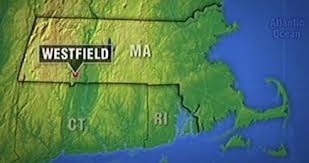
**
By far, the most important customer of Aero Aviation was a very famous multi-millionaire from New York City.
**
He was the grandson of one of the well known robber baron businessmen of the turn of the previous century and was as well known as the likes of J.P. Morgan or Andrew Carnagie.
**
He shall remain nameless in this book, but we called him “The Boss”.
Page 146

**
The Boss owned a large executive transport airplane which he kept in the Aero Aviation Hangar at Barnes Airport.
**
The airplane was a Lockheed Lodestar Super Ventura, a World War II military transport which had been converted into a very plush executive private airplane.
**
We nicknamed this airplane “The Bomber”.
**
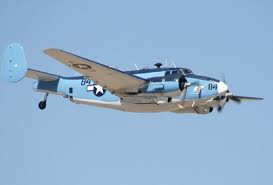
Lockheed Lodestar PV-1
**
As this huge airplane took up a great deal of space in our hangar, The Boss paid a substantial amount of money to our company for the rental of this space.
**
As this airplane was very old and very complex, it was always in need of some sort of maintenance.
**
We were able to keep our mechanics busy, even during slow periods, by having them work on the Bomber.
**
When the Bomber flew, our company made large profits on the sale of the huge amounts of fuel the Bomber consumed.
**
The Boss lived in a penthouse suite on Park Avenue in New York City.
**
The pilots who flew the Bomber for The Boss lived in the Westfield area in order to be close to the airplane.
**
The co-pilot, John Green, was a citizen of Bermuda, a small British owned island/country in the middle of the Atlantic Ocean.
**
When he wasn't flying as co-pilot on The Bomber, John worked as a part time flight instructor for our company.
**He was a soft spoken and pleasant person.
**
The pilot/captain of the Bomber, Gene Striker, was exactly the opposite of his co-pilot.
**
**
He was about 55 years old. He was a large and muscular man with wild and wavy white hair. He looked like the former Governor of Texas, John Connally.
 **
**
**
Gene was an extremely aggressive and sometimes belligerent man. Everyone was afraid of him and tried to avoid him.
**When he gave an order, everyone jumped.
**
I also tried to stay out of his way.
**
I often watched him, from time to time, as he screamed at the owner of our company, Jack Matthews, at his co-pilot, John Green, and/or at our mechanics, when he felt they had not done something exactly as he ordered.
Page 147

**
Athough I tried to avoid him, he always treated me well and our relationship was cordial, if not friendly.
**
One day, soon after I began working for Aero Aviation, John Green, the co-pilot, told me they planned to make a flight in the Bomber to the Island of Bermuda, where The Boss had a home.
**
As mentioned, John was a citizen of Bermuda.
**
John Green and The Boss were both experienced scuba divers.
**While diving off Bermuda a few months earlier, John and The Boss found a previously un-discovered Spanish galleon sailing ship which they learned sank in a storm in the 1700’s.
**
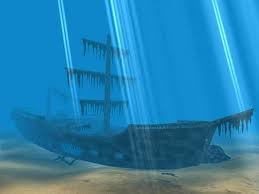 Shipwreck
Shipwreck
**
As these ships were known to have transported large amounts of gold, The Boss and John registered this wreck with the Bermuda government for salvage.
**
The purpose of this trip to Bermuda was to take The Boss, John Green, and a group of their friends, to begin their dives to this sunken ship to search for gold and other treasures.
**
John and The Boss were going to remain in Bermuda in order to conduct their treasure hunt and they needed a temporary co-pilot to assist Gene Striker in flying and navigating the Bomber back to Westfield.
**
Gene asked John to ask me if I was interested in making this flight and serving as co-pilot on the Bomber on the return flight.
**
I heard many rumors of how Gene treated his co-pilots, including John Green.
** He was famous for constantly criticizing and reprimanding his co-pilots. Gene never allowed his co-pilots to fly the airplane, which was unusual.
**
Most captains routinely share the flying duties with their co-pilots, but not Gene.
Page 148

**
I recalled a story I heard about the time the owner of Aero Aviation, my boss, Jack Matthews, flew as co-pilot with Gene.
**
As they sat down in their seats to begin the flight, Jack began to tune the radios to the appropriate control tower frequencies, which is the co-pilot's normal responsibility.
**
As Jack started doing this, Gene abruptly and forcefully slapped Jacks hands down off the radios, glared at him, and screamed “Keep your God-damned hands off the doo-dads”.
**
But, I decided, in spite of the risks of flying with Gene, this trip to Bermuda in the Bomber would be a great adventure and a great experience.
**
So, I agreed to make the flight.
**
We left Westfield very early on a Saturday morning.
**
The weather was clear. It was a beautiful day for flying.
**
John Green had already gone to New York to meet with The Boss and plan their dives.
**
Gene and I were to fly alone in the Bomber to LaGuardia Airport in New York City.
**
We were to pick up The Boss, John Green, and about 10 or 15 people who would accompany them to Bermuda.
**
Pulling the Bomber out of our hangar was an ordeal.
**
Our mechanics attached a truck to the landing gear and slowly and meticulously, under the watchful eye of Gene Striker, pulled the huge airplane out onto the ramp.
**
Gene and I got aboard.
**
I was amazed at how plushly appointed and decorated the interior of the airplane was. There was carpet on the floor and walls, leather couches and lounge chairs, a full bar, TV’s, stereos, etc . . . . . . I was impressed.
**
The Bomber had a huge flight deck where the pilots sat which was separated from the passenger cabin by a door.
**
In addition to the pilots seats, there were navigation tables
and plenty of room to walk around.
Page 149

**
There were hundreds of switches, gauges, dials, and circuit breakers, all over the walls and ceiling.
**
I had no idea what any of those things were.
**
 Lockheed PV-1 Cockpit
Lockheed PV-1 Cockpit

**
I knew Gene did not need nor want my help in flying the airplane. He did everything himself.
**I knew I was only there because FAA Regulations require that an airplane of that size must have at least two pilots on board.
**
As we sat down into the pilots seats, I remembered what I heard about the way Gene reacted when Jack Matthews tried to tune the radios.
**
I immediately told Gene I was not going to do anything or touch anything unless he told me to.
**
Gene said that would probably be a good idea.
**
He started the enormous 2000 horsepower, 18 cylinder, Pratt & Whitney Double Wasp R-2800 Radial Engines.
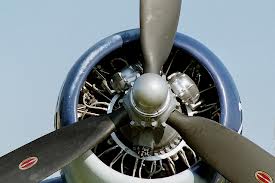 Pratt & Whitney R-2800 Engine
Pratt & Whitney R-2800 Engine

**
**
Even at idle, we could feel the tremendous power of these engines.
**
Gene began taxiing to the runway. I was amazed at how much work it was for him to control this airplane.
**
The airplanes I flew seemed incredibly easy to operate compared to this unruly monster. Gene struggled to taxi and steer the Bomber.
**He began to sweat.
**
When we received our take-off clearance from the tower, Gene pulled a lever on the floor. This lever locked the tailwheel in place and helped the airplane go straight down the runway during the take-off roll.
**
He then applied full power to the engines.
**
We accelerated down the runway. I was further impressed with the power of the engines and at how rapidly we gained speed.
**As the Bomber was a “Tail dragger”, Gene had to get the tail of the airplane up off the runway during the take-off roll.
Page 150

**
As this is a somewhat difficult maneuver, especially in a
large airplane, I could see that Gene was very skillful at controlling the Bomber.
**
We lifted off the ground at 120 MPH and the airspeed continued to increase all the way up to 250 MPH.
**
We headed southwest toward New York City.
**
So far, I hadn’t done anything. I asked Gene if there was anything he wanted me to do. “Not yet”, he said.
**
He pointed to the airspeed indicator. It indicated 260 MPH.
** “Pretty fast, huh”, he said.
**“Amazing”, I replied.
**
Gene smiled and proceeded toward LaGuardia Airport.
**
(Until about that time, if the weather was good, aircraft were allowed to overfly the crowded airspace over major cities without contacting air traffic control (ATC).
**Aircraft were only required to contact ATC within 5 miles of a major airport and only if below 2000 feet of altitude.
****(For pilots - the ceiling of an Airport Traffic Area was raised from 2000 feet to 3000 feet in the early 1970's)
**
In the late 1960’s, because of increased air traffic and the danger of mid-air collisions, the FAA established Terminal Control Areas (TCA’s) around all the major airports in the US.
**
These TCA’s (Now known as "Class B" Airspace) were large areas of airspace, averaging 20 to 30 miles in diameter, extending up to 7000 feet in altitude.
**
While still free to enter and/or overfly these busy areas, aircraft first had to be identified and tracked on radar while inside the TCA).
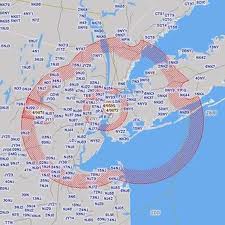 New York TCA
New York TCA
**
Gene was an old school pilot who hated anything new and who particularly hated having to comply with the new rules pertaining to entering the TCA’s.
**
As we neared the boundary of the New York TCA, I noticed Gene had not yet tuned the communication radios to the frequency of the LaGuardia Radar Approach Control.
Page 151

**
I was concerned, but, I did not dare to question Gene.
**
As we got even closer to New York, Gene seemed oblivious to the requirement that we contact the approach control prior to entering the TCA.
**
As we crossed the boundary of and entered the TCA, I suspected maybe he had forgotten about the new rules and I knew it was my duty as co-pilot to assist him.
**
So, I decided to take a chance.
**
I told Gene I believed we were already in the TCA.
**
I expected Gene to rip my face off, but he didn’t.
**
He grumbled and cursed and tuned the radio to the proper frequency.
**
He tried to call LaGuardia Approach Control. They didn’t answer us. He tried again. They still didn’t answer.
**
Under these circumstances, an aircraft is expected to remain outside the TCA until receiving permission to enter.
**
However, although we were now well inside the New York TCA, we still had not received clearance to enter it.
**We kept proceeding toward LaGuardia Airport.
**As it was only 6:45 AM, I mentioned that maybe there was no one in the Radar Facility. “They’re there”, Gene said.
**
As we were now only a few miles from the Airport, Gene decided to bypass the radar approach control and contact the control tower directly. He radioed the LaGuardia Tower and told them we were about 5 miles northeast of the airport and we were inbound for landing.
**
The tower controller began to chastise Gene for entering the TCA without permission.
**
Gene was already very agitated. He told the controller that we tried to call the approach control, but, they had not answered.
**He sarcastically asked if the controller expected him to stop the airplane in flight while he waited for the Approach Control to answer.
Page 152

**
The tower controller replied that he expected Gene to stay out of the TCA until receiving clearance to enter it.
**
Gene told the tower controller that maybe the controllers in the radar facility should wake up and do their jobs.
**
The tower controller answered that maybe Gene should go back to school so he could learn to understand the FAA Regulations.
**
Gene told the tower controller his 90 year old grandmother could do a better job of controlling air traffic.
**
It was still very early and there were no other airplanes in contact with the Tower.
**
Gene and the tower controller argued all the way in to the airport.
**
The conversation got hotter and hotter as we got closer to LaGuardia. I was shocked and amazed.
**
I never heard a pilot say such things to a controller.
**
As we turned onto final approach, Gene and the controller were still arguing.
**
(LaGuardia Airport is on the coast of Long Island Sound.
**The runway lengths have been extended onto landfills which have been built out into the water.
**
At the threshold of the runway we used, there is a dike which is about 15 to 20 feet high. This dike helps keep the sea water off the runway and also diverts the jet blasts of the departing airliners up and away from the pleasure boats anchored in Flushing Bay).
 LaGuardia Airport - New York City
LaGuardia Airport - New York City
**
Gene made a lower than normal final approach to the runway and we barely cleared the dike.
**
As we crossed over it, the tower controller sarcastically said, “You cleared that dike by only about 3 feet”.
**
Gene snapped back, “It was exactly 3 feet”.
**
They continued their argument as we taxied to the ramp.
Page 153

**
When we arrived at the Marine Air Terminal (The area of LaGuardia used for private airplanes), I was relieved the ordeal between Gene and the Tower controller was finally over.
**
I was wrong. . . In fact, it was just beginning.
**
As we got out of the airplane, a fuel truck was already filling our tanks for the trip to Bermuda.
**
Before the fueling was finished, Gene said, “Lets go”.
**
I followed, but, I didn’t know where we were going.
**
We got into a jitney bus which took us across the airport to the main airline terminal. It was now 7:00 AM.
**
We walked through the terminal and through a series of hallways and corridors to an elevator. Gene had not said a word since we left the Marine Air Terminal.
**
Gene spoke to someone on a telephone near this elevator.
**
I couldn’t hear what he was saying.
**
We got into the elevator and up we went.
**
The elevator door opened.
**
We were high up in the LaGuardia Airport control tower.
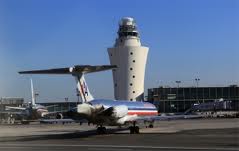 Control Tower - LaGuardia Airport
Control Tower - LaGuardia Airport
**We had a birds eye view of the entire airport, including all of the runways and taxiways.
**
We could see all the airliners parked at the main terminal, and the Bomber and the other airplanes parked across the airport at the Marine Air Terminal.
**
We could also see the buildings in Manhattan, the waters of Long Island Sound, and, of course we could see the controllers in the control tower sitting at their consoles and controlling the air and ground traffic at the airport.
**It was still early and there was very little activity at the airport.
**
I didn’t know what Gene had in mind, but I knew I didn’t want any part of it.
**
Gene shouted, “Which one of you sons of bitches was the one I was just talking to on the radio”.
Page 154

**
The elevator had already left.
**
I began nervously pushing the down button to recall the elevator, but it didn’t come back.
**
The tower chief ran up to us.
**
He obviously knew Gene as he called him by name.
**
“Gene”, the tower chief said, “Please calm down”.
**
Gene would not be pacified. Gene put up his fists and yelled, “I’ll fight you bastards individually or collectively”.
**
I pushed the elevator button a little harder and faster, but it still wouldn’t come back.
**
After a 10 minute screaming match between Gene, the tower chief, and the controller who had worked our arrival, Gene finally calmed down.
**
It was obvious Gene had done this sort of thing before and was well known to these controllers.
**
(I’m sure one of the reasons the tower controllers were so tolerant of Gene was they knew the owner of the Bomber, The Boss, was one of the richest and most famous people in the world, and Gene was his personal pilot).
**
Still, it was a situation which would never be tolerated in the security conscious and intolerant environment of today.
**
Today, our entering the New York TCA without clearance and Gene’s behavior in the tower would be met with a completely different response.
**
We went back to the Marine Air Terminal to wait for our passengers to arrive. I remember thinking Gene Striker was everything I heard he was . . . . . and more.
**
Page 155

**
(As mentioned, the Marine Air Terminal at LaGuardia Airport now serves as the private aircraft terminal.
This famous building on the coast of Long Island Sound, in the 1930’s and 1940’s, during what has become known as “The Glory Days of Aviation”, served as the terminal from which the giant 4-engine Pan American World Airways Sikorsky Flying Boats (Clippers) departed on their around the world voyages, hence the name “The Marine Air Terminal”.

**
This trip to LaGuardia Airport with Gene Striker was my first visit to the Marine Air Terminal.
**
Over the next 15 years, I would visit this legendary place countless times.
**
As LaGuardia is the nearest airport to Manhattan, (the center of most activity in New York City), it is the preferred airport for all those actually going into the City, as opposed to JFK Airport, which is much farther out and is used mostly for connecting and international flights.
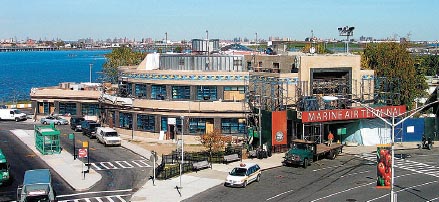 Marine Air Terminal - LaGuardia Airport
Marine Air Terminal - LaGuardia Airport
**
As most prominent and/or wealthy people travel by private aircraft, the Marine Air Terminal at LaGuardia is frequented by a “who’s - who” of America, and of the world.
**
During my years as a pilot, I made many-many trips to New York City and spent many-many hours at the Marine Air Terminal.
**
I often saw Jackie Kennedy Onassis and her children leave for and arrive from Greece in her husband Aristotle Onassis’ private Learjet.
**
I also saw many other famous people, such as singer John Denver, actor Cliff Robertson, singer James Brown, and many-many other well known personalities of the business and entertainment worlds, as well as many well known political figures, at the Marine Air Terminal at LaGuardia.
**
It is the center of the universe for corporate and private air travel.)
Page 156

**
As Gene Striker and I got back to the Bomber, our passengers were beginning to arrive. Their limousines drove out onto the ramp and up to the airplane.
**
We were all introduced and we left for Bermuda at about
8:30 AM. The controllers in the LaGuardia Tower were very courteous and polite when we taxied out and took off.
**
Gene, as always, was in the left, or, captains seat, and John Green was in the right, or, co-pilots seat.
**
I sat at a table behind them during the take-off.
**
This position had been the navigators seat when this airplane served as a military transport during World War II.
**
We climbed to our cruising altitude of 11,000 feet and headed Southeast, out over the Atlantic Ocean, toward the Island of Bermuda.
**
There were many ships entering and departing New York Harbor.
**
I watched the New York skyline disappear behind us.
**
After leveling off, Gene engaged the autopilot, slid his seat back, and began to read a magazine.
**
John Green asked Gene if it was OK if he went back into the passenger cabin to be with The Boss and his group.
**
Gene said it was OK with him.
**
As John opened the door to the passenger cabin, we could see there was a party going on back there. There was loud music playing and people were dancing. A uniformed waiter was walking through the cabin carrying a tray which contained snacks and drinks.
**
The waiter, seeing the door to the flight deck open, brought us some sandwiches and soft drinks.
***
(For a new pilot, like myself, to be aboard a flight like
this was a unique experience. I felt very fortunate to be on this trip aboard the Bomber and to be among those people).
Page 157

**
At our cruising speed of 275 MPH, it took almost 3 hours for the Bomber to reach Bermuda from New York, so, I tried to relax during the flight.
**
I began to read a magazine, but, couldn’t concentrate.
**
While at flight school in Florida, we did some overwater flying to the Islands of the Bahamas, which are a hundred or so miles off the Southeast coast of Florida, and we had been out of sight of land many times before.
**
However, Bermuda is almost 800 miles out into the North Atlantic Ocean, which is much farther out to sea than the Bahamas.
**
I kept looking at the ocean all around the airplane.
**
It was a beautiful sight.
**
I also kept watching the fuel quantity, oil pressure, and the other gauges on the instrument panel.
**
Everything seemed normal.
**
(When flying over water, and out of sight of land, many pilots develop what is known as “Automatic Rough”.
**That is – aircraft sounds, vibrations, and other noises, which are hardly noticed over land – suddenly become louder and more intense when flying over water.
**Every sound, noise, or vibration, real or imagined, seems to signal an impending catastrophic mechanical failure.
**This is a condition, sometimes resulting in very comical behavior, that plagues many pilots on long or short overwater flights).
**
John Green returned to the flight deck to instruct me on the use of the LORAN (Long Range Navigation) system so I could plot our position on the return flight.
**
I studied many advanced navigation systems while at college, including celestial, inertial, LORAN, and others.
**
However, the LORAN set in the Bomber was extremely old and, unlike the new and more modern LORAN receivers, it was complicated to use.
**
It took about 5 minutes to plot a fix.
**
(Determining your position, when flying over water or on a ship and out of sight of land, has been one of the greatest challenges to navigation since the beginning of travel for hundreds and even thousands of years.
**There have been many methods of navigation developed over the years, some accurate, and some not so accurate.
**
The LORAN navigation system, (Which is accurate to within a few miles), was implemented and was maintained worldwide by the US Navy for use by its ships, which travel at about 20-30 miles per hour.
**But, the Bomber flew at almost 300 MPH.
**In the 5 minutes it took to plot our position using this older LORAN receiver, the Bomber traveled almost 25 miles.
**Therefore, the position fix obtained using this LORAN set was only a close estimate.
**Of course, all these older navigation systems are primitive when compared to the incredible capabilities of todays satellite based “Global Positioning System” (GPS), which displays instant and exact position anywhere in the world to within a few feet.
**In my opinion, the Global Positioning System must be considered one of the greatest technological achievements in the history of mankind.
** GPS, while a novelty and a toy when used in an automobile, is a reassuring and sometimes lifesaving system when used by pilots on long flights over water or when flying at night over unfamiliar terrain and low on fuel).
Page 158

**
John explained how to use the LORAN receiver and, before long, I was able to determine our approximate position by using this LORAN set.
**
John said Gene would probably not ask for a position fix on the way back, but, I should probably be ready to give him one in case he did.
**
I knew that was good advice.
**
As we approached Bermuda, The Boss came into the flight deck.
**
He told us his yacht was anchored over the sunken Spanish ship and asked if we could make a low pass over the yacht so the people on board would know we had arrived.
**
Gene said we could.
**
The yacht was anchored about 5 miles northwest of Bermuda.
**Flying over it required only a minor deviation from our course.
**
We descended to about 200 feet above the water.
**As we passed over the yacht, Gene banked our wings, left and right, as a greeting.
**The people standing on the deck waved as we flew overhead.
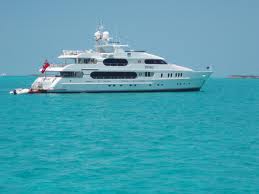
**
I remember thinking how very beautiful the blue and turquoise ocean and the pink beaches of Bermuda looked from the airplane.
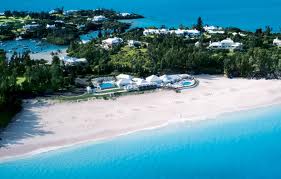
**
We landed at the US Naval Air Station on the Island of Bermuda and parked on the civilian side of the airfield.
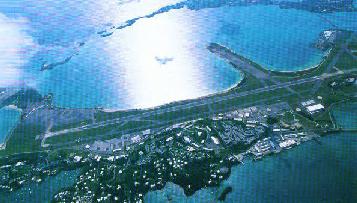 US Naval Air Station/Island of Bermuda
US Naval Air Station/Island of Bermuda
**
After we landed, more limos drove up to the Bomber.
**
We all shook hands and The Boss, John Green, and their party went on their way.
**
Gene and I prepared the airplane for the return flight.
**
Gene got out of the airplane first.
**
As I got out, Gene was having a loud conversation with the driver of the fuel truck.
**
This driver appeared to be about 18 years old.
Page 159

**
Gene seemed upset that this fueler parked his fuel truck too close to the Bomber. (It seemed to be parked OK to me.)
**
The driver seemed a little frightened.
**
I couldn’t hear exactly what Gene was saying, but, he seemed to be inquiring as to how this fuel truck driver might feel about having a size 12 shoe inserted into a certain part of his anatomy.
**
The driver scrambled back into his fuel truck and quickly repositioned it a little farther away from the Bomber.
**
I felt a little bad for this driver, but, compared to the incident that morning in the LaGuardia Airport control tower, this incident was relatively mild.
**
We flew non-stop from Bermuda back to Westfield.
**
Gene navigated by using a high powered radio navigation beacon which is located on Nantucket Island, off the Massachusetts coast.
**
The return flight was uneventful.
**
Gene read his magazine, while I, sitting at the LORAN navigation table, kept track of our location in case Gene asked for a position fix . . . . He didn’t.
**
As we neared Nantucket, Gene asked me to get back into the co-pilot's seat. He then did something which, I was told, he had never done before.
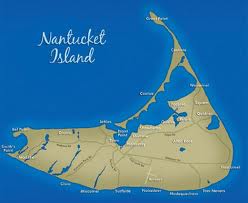
**
He asked me if I wanted to fly the Bomber.
**
I really had no desire to fly the airplane as flying an airplane during the cruising portion of a flight is not very exciting or challenging.
**
Not wanting to appear unappreciative of this kind gesture, I told Gene I would very much like to.
**
Gene disengaged the autopilot and I took the controls.
Page 160

**
As we passed over Nantucket, Gene told me to make a left turn to the Northwest, toward Westfield.
**
While in the turn, he asked how the airplane felt.
**
I said it felt “Big.”
**
He laughed and said he was going to re-engage the autopilot.
**I had flown the airplane for about 5 minutes.
**
I thanked Gene. I felt honored.
**
After we landed at Westfield, I went into our company flight office. A few minutes later, Gene came in. He asked how much he should pay me for my services as co-pilot.
**
I was surprised.
**
I told him todays flight to Bermuda had been a fantastic experience and I didn’t expect to be paid.
**
He said, “How about two-hundred dollars.”
**
I repeated I didn’t expect to be paid as I really didn’t do anything.
**
He shoved the money into my shirt pocket, shook my hand, and left.
**
I felt rich.
**
Two hundred dollars was over two weeks pay for me.
**
That was a day I will never forget.
- - - - - - - - -
**
A couple of months later, Gene telephoned me. He said John Green was on vacation and he wanted to know if I was interested in making another flight with him in the Bomber.
**
I said I would like to and asked him where we were going.
**
He said I wouldn’t believe it so he would tell me later.
**
He said it would only be a short trip and we would be home by that evening.
**
When we got to the airport, before take-off, I asked Gene again where we were going.
Page 161

**
“You won’t believe what The Boss wants us to do,” he said,
“I’ll tell you later.”
**
We took off in the Bomber.
**
I could see we were headed toward New York City.
**
Gene told me to call LaGuardia Radar Approach Control on the radio to obtain clearance to enter the New York TCA, which I did. We landed at LaGuardia Airport without incident and parked at the Marine Air Terminal.
**
“Are you ever going to tell me where we’re going”, I asked Gene. “You’ll find out soon enough”, he said.
**
A few minutes later, a pick-up truck drove out onto the ramp and up to our airplane.
**
“There’s our passenger”, Gene said. I looked to see two men loading a washing machine onto the Bomber.
**
“The Boss wants us to deliver this beat up old washing machine to him at his home on Marthas Vineyard“.
**
(Marthas Vineyard is another resort island off the coast of Massachusetts, near Nantucket Island).
**
“Can you believe it”, Gene said. “It costs over a thousand dollars an hour to operate this airplane. The Boss could buy 10 brand new washing machines for what it’s going to cost him to bring this old one out to Marthas Vineyard.”
**
Gene cursed and swore for the entire flight. I sat there and listened to him vent his frustration on the Gods.
**
While I always got along well with, and I guess I liked Gene Striker, I often wondered how such a man could be the personal pilot of someone of the stature of “The Boss”.
**
One day, a few weeks after that flight to Marthas Vineyard, I was having lunch with John Green at the Westfield Airport Restaurant, so, I asked John if he knew.
**
John said The Boss felt a strong sense of loyalty to Gene.
**The story he told me sounded like something out of a Hollywood movie.
Page 162

**
It seems that one day, many years ago, while skiing at Aspen Colorado, The Boss had a serious accident requiring immediate treatment.
**
As Aspen is remotely located deep within the Rocky Mountains, the medical facilities there were unable to treat him. To make matters worse, there was a severe blizzard in progress and all the roads to and from Aspen were closed.
**
According to John Green, Gene Striker flew through the blizzard and through the mountains around Aspen, managed to find the airport through the snow, and picked up The Boss, who had arrived by ambulance.
**
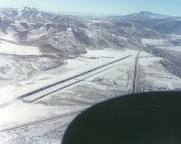 Aspen Airport - Aspen Colorado
Aspen Airport - Aspen Colorado
**
Gene then flew The Boss to Denver, arriving there just in time to receive the necessary medical attention, thereby, saving his life.
**
According to John, Gene and The Boss became very close friends after that incident.
**
By the late 1960’s and early 1970’s, most people of the economic stature of The Boss had acquired jet airplanes for their personal transportation.
**
The Bomber, although plushly appointed, was an old fashioned airplane, more typical of the 1930’s or 1940’s.
**The Boss had been pressuring Gene for some time to get rid of the Bomber and get them a jet.
**
However, Gene, being very set in his ways, was intimidated at the prospect of learning to fly a high altitude and high performance jet airplane and resisted this pressure from The Boss for a long time.
**
Because of this friendship with Gene, The Boss kept the Bomber for a lot longer than he should have.
**
A year or so after our trip to Bermuda, The Boss, having given up trying to persuade Gene to get rid of the Bomber, decided to sell the airplane and to discharge Gene and John.
**This was also a major economic blow to our company.
**A few months later, we learned that The Boss had finally purchased a luxurious private jet and had hired a different crew to fly it.
**
(A sad footnote to this story : After being sold to a Texas company in 1975, the Bomber crashed in Culiacan Mexico – killing everyone on board).
Page 163

**
(Regarding the independent and sometimes defiant actions of Gene Striker and some other pilots of that era, including myself, I submit the following - - -
**I believe the Federal Aviation Regulations are reasonable, have been formulated with the goal of enhancing the safety of flight, and must be respected and adhered to.
**I have always had great respect for the FAA.
**Therefore, I do not approve of nor condone some of the actions described in this and other chapters.
**- - - Having said that, I also submit the following - - -
**
Flying an airplane is an enormous responsibility requiring considerable knowledge, skill, and judgment, and is filled with many unpredictable and sometimes unexpected variables and uncertainties - - -
**Only the pilot know the safest course of action at any given moment or circumstance, and the FAA Regulations acknowledge this fact in that they give the pilot “Final authority as to the operation of the airplane” - - -
**But, sometimes, (Hopefully rarely) following the rules might actually place an airplane in a more dangerous situation.
**For example - when low on fuel, it may be necessary to descend below legal landing minimums during an instrument approach in bad weather.
**There are countless other similar situations
**
Most pilots do not abuse this “Final authority” as it is vitally important for the safety of flight for the pilot to do what is necessary for safety, regardless of what strict interpretation of the Regulations may require.
**The FAA permits this because, as stated before, unlike Doctors, Lawyers, or other professionals, pilots must suffer the consequences of our decisions, along with our passengers.
**In spite of our sometimes “Fun-loving” behavior, pilots have often risen to almost “Superhuman” levels of performance in order to save their passengers, their airplanes, and, themselves.
Therefore, some people believe that an independent and strong willed nature may actually be a desirable asset in dealing with the pressures and responsibilities of flying.
- - - - - - - - - - - - - - -
**
In recent years, beginning in the 1980’s, soon after the rare, unusually aggressive, and overbearing actions of a domineering European airline captain caused the worst disaster in aviation history, the FAA has attempted to tightened the rules regarding aviation, and, I believe, has tried to limit the authority of the “Pilot in Command”.
**
Today, pilots are routinely issued violations for even minor infractions of the FAA Regulations, sometimes, even when the pilot explained that his/her actions were dictated by the requirements of safety.
**This would have been unheard of in the past, because, as described above, not all infractions of the rules are the result of deliberately careless or reckless actions.
**
In earlier times, there was co-operation between air traffic controllers and pilots. We seemed to work together and often “Covered” each other’s mistakes.
**
Today, because the FAA now disciplines air traffic controllers for not reporting pilots for even minor infractions of the rules, and rewards controllers when they do report pilots, the pilot/controller relationship sometimes seems to have deteriorated into an almost adversarial situation.
**
Air Traffic Controllers seem to have been transformed from their former positions as organizers of air traffic, to their seemingly new function as the “Air Police”.
**
Today, this added pressure, and the fear of being issued a violation, has, in my opinion, weakened pilots command authority, and reduced our spirit of independence and willingness to make difficult decisions.
**
Sadly, it seems that pilots and other aviation professionals have allowed themselves to join the many other non-pilot citizens/victims of the intolerant and police-state environment of today, where aggressive air controllers can angrily chastise pilots for even very minor and totally insignificant variations of flight procedures.
**Even aircraft autopilot systems are now programmed to angrily and repeatedly verbally scold pilots for even small variations in flight procedures.
**
In the days of Gene Striker, pilots would never have tolerated this kind of totally unnecessary loss of command authority and respect, as even back then, as it is today, aviation was, by far, the safest means of transportation in the history of the World.
**
Although the aviation safety record may have slightly improved since the 1980’s, I still long for and miss the freedom and independence we pilots once enjoyed in a country where freedom was enjoyed, appreciated, and cherished, and every movement, action, and even thought, was not monitored and controlled.
(In my opinion, most of this “Improved” aviation safety record can be attributed to modern day better weather reporting, more accurate navigation aids, improved aircraft instrumentation, increased simulator training, and other things unrelated to the deliberate reduction of pilot’s command authority).
Page 164
|





